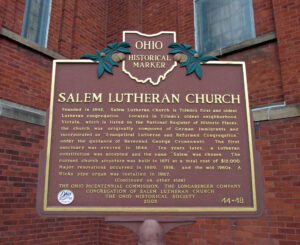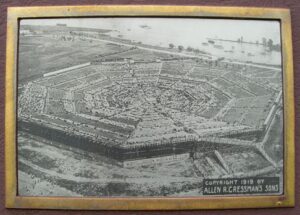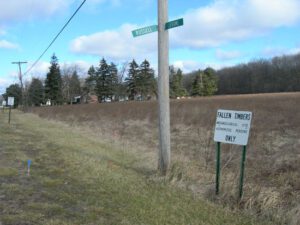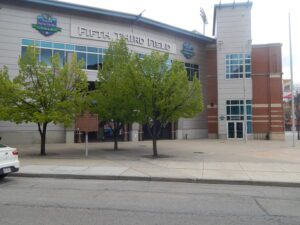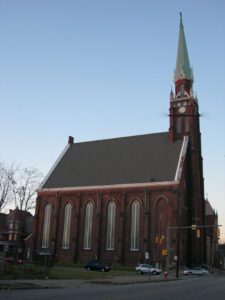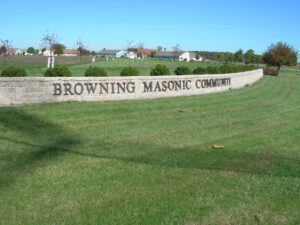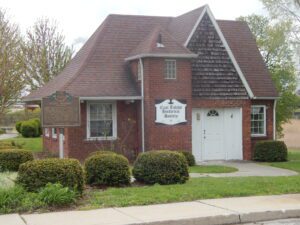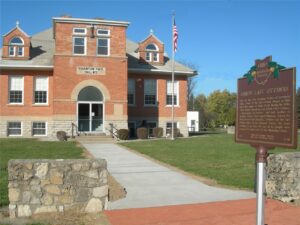, OH
Founded in 1842, Salem Lutheran Church is Toledo’s first and oldest Lutheran congregation. Located in Toledo’s oldest neighborhood, Vistula, which is listed on the National Register of Historic Places, the church was originally composed of German immigrants and incorporated as “Evangelical Lutheran and Reformed Congregation” under the guidance of Reverend George Cronenwett. The first sanctuary was erected in 1844. Ten years later, a Lutheran constitution was accepted and the name “Salem” was chosen. The current church structure was built in 1871at a total cost of $12,000. Major renovations occurred in 1889, 1916, and the mid 1960s. A Wicks pipe organ was installed in 1967. (continued on other side)
, OH
Jess Willard, the 6′ 6″ 245-pound boxing champion, was a shy and gentle Kansas native who had won the championship from Jack Johnson of Texas in 1915 in Havana, Cuba. Jack (William Harrison) Dempsey of Manassa, Colorado, hailed as the greatest fighter of the half-century by the Associated Press, began his career in 1911, defeating opponents with his trademark bobbing and weaving style. Dempsey’s manager, Jack “Doc” Kearns, captured the attention of fight promoter Tex Rickard, who was looking for a Willard challenger. Despite the size and weight difference of the boxers, the bout was arranged.
, OH
The Battle of Fallen Timbers, fought on August 20, 1794, is one of the most significant events relating to post-Revolutionary War America. Major General “Mad” Anthony Wayne led the Federal Army, known as The Legion of the United States against a confederacy of Native Americans led by Miami Chief Little Turtle and Shawnee war chief Blue Jacket. Defeat in battle and lack of help from their nearby British allies disheartened the tribes and lead to the 1795 Treaty of Greenville. The Treaty secured United States control of the Northwest Territory and ultimately resulted in the formation of five new states-Ohio, Indiana, Michigan, Illinois, and Wisconsin. (continued on other side)
, OH
Moses Fleetwood Walker was born on October 7, 1856 in Ohio to Moses M. Walker, a physician, and Caroline, a midwife. He attended and played baseball at Oberlin College and the University of Michigan. In 1883, Walker joined the newly formed Toledo Blue Stockings and became the first African American major league ballplayer when Toledo joined the Major League-sanctioned American Association the following year. As a barehanded catcher, his biggest assets were his catching ability, powerful throwing arm, and aggressive base running. He endured racial prejudice from teammates, opponents, and baseball fans, and eventually left to become a writer, inventor, civil rights advocate, and entrepreneur. Walker was elected to the Ohio Baseball Hall of Fame in 1991. He died in 1924 and is buried in Stuebenville, Ohio in the family plot at Union Cemetery.
, OH
Construction for the current St. Anthony Church began in 1890 after the original wood-frame church became too small to serve the steadily growing congregation of Polish immigrants coming into the Toledo area. Completed in 1894, St. Anthony was the second Polish church built in Toledo and became known as the “mother” church for the local Polish community serving as many as 8,000 parishioners piror to the 1970s. The first Mass was celebrated on March 4, 1894. (continued on other side)
, OH
This location was selected in 1936 for a Memorial Home for aged Masons, at the wishes of Otis Avery Browning. Browning, a prominent Toledo businessman, book publisher, civic leader, and Mason, set forth the plans for this Home in a will he prepared in 1922, creating a trust for the Otis Avery Browning Masonic Memorial Fund. His will states, “It is one of the chief purposes of my will, that I may become an instrument, under God’s directing care, in providing for the erection and maintenance of a home for aged people, where they may be properly cared for and with all modern comforts.”
, OH
Considered the first citizen of the East Side, Peter Navarre, along with his brother Robert, first settled the land east of the Maumee River in 1807. A fur trader by profession, Navarre was experienced in wilderness survival and had a deep understanding of Native American life. He died on March 20, 1874, and was buried at Mt. Carmel Cemetery across the river from his beloved East Toledo. In 1922, the City of Toledo declared September 9th Peter Navarre Day, an official city holiday. This marker commemorates the 200th anniversary of the founding of East Toledo.
, OH
Here in the Oak Openings Region of northwest Ohio, some of the last Ottawa villages in Ohio lined the banks of Swan Creek during the 1830s. These Native Americans were led by Chief Ottokee (Autokee), a descendant of Pontiac, and half brother to another Ottawa Chief named Wauseon. Known for being honest and friendly, Ottokee was the last Ottawa chief in the Maumee Valley, for years refusing to go when the last of his people were removed to lands west of the Mississippi River.


